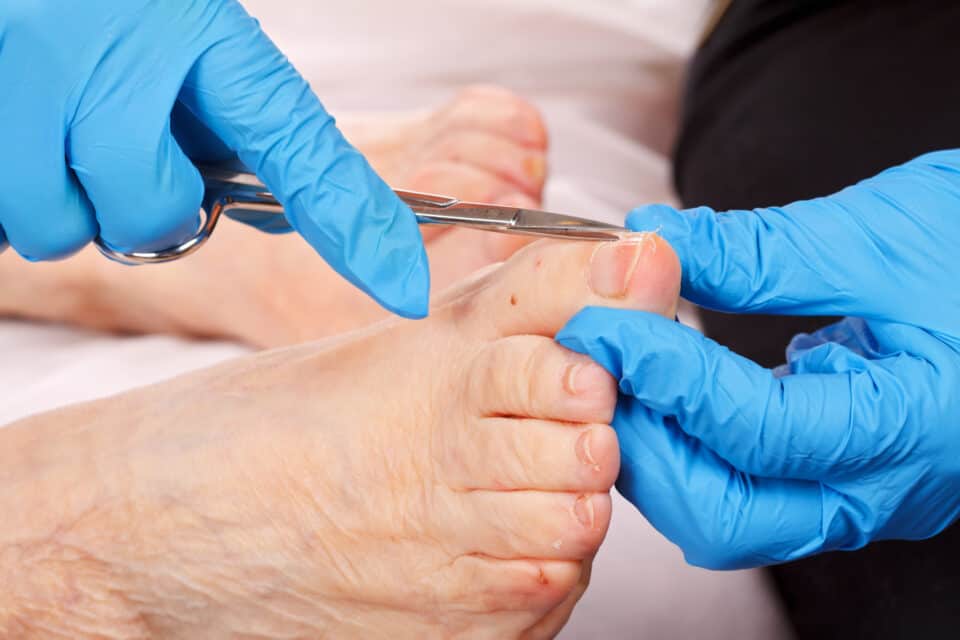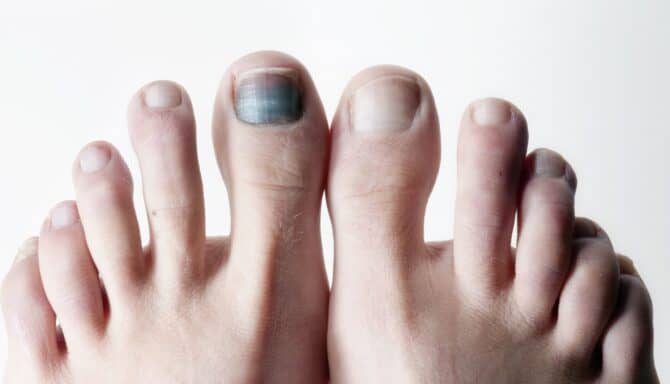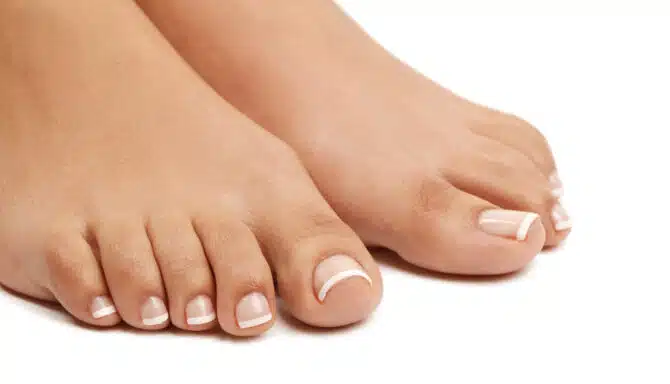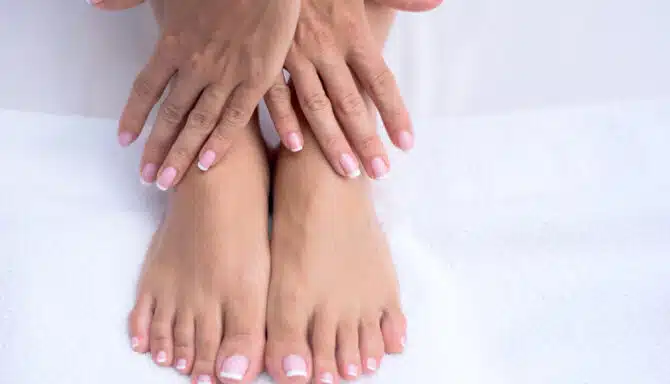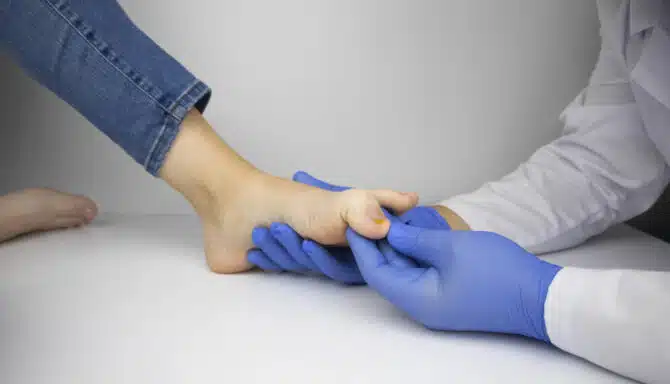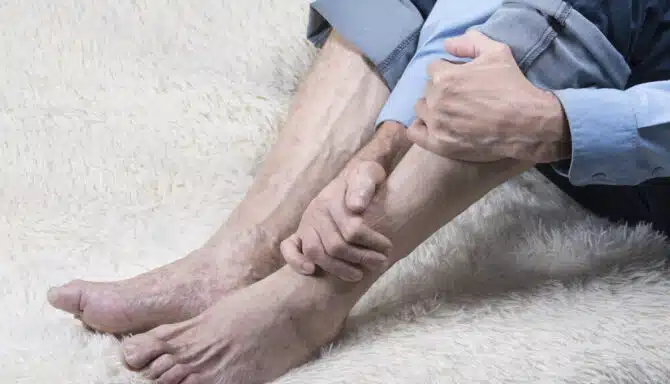January 30, 2025
Toenail conditions can cover a wide range of problems, each with its own set of symptoms. Typical causes and risk factors include wearing ill-fitting shoes over long periods, contracting contagious fungi, infections, cutting your toenails incorrectly, having poor circulation and more. Today we’ll talk about the 5 most common toenail conditions and what you can do to address each one. Nailed it!
5 Common Toenail Conditions
Ingrown toenails
Toenail fungus
Cracked/stubbed toenails
Discoloured toenails
Onycholysis
Risk Factors for Common Toenail Problems
Improper nail trimming, such as cutting nails too short or rounding edges.
Wearing tight or ill-fitting footwear that puts pressure on the toes.
Frequent exposure to damp or moist environments - this leads to fungal infections, which can spread and worsen without treatment.
Walking barefoot in communal areas, which increases exposure to fungi and bacteria.
Trauma to the toes, such as stubbing or dropping heavy objects.
Poor foot hygiene, leading to debris buildup and a more favourable environment for bacteria and fungi.
Genetics, including naturally curved nails or a family history of nail issues.
Poor circulation, which disrupts the natural toenail growth process and can lead to an array of toenail deformities and misshapen toenails.
Medical conditions like diabetes or peripheral vascular disease, which impair circulation and healing. It's extremely important to attend regular appointments with a chiropodist or podiatrist if you have diabetes as even deceptively minor issues, like cracked toenails or ingrown toenails, can turn into diabetic ulcers when ignored.
Psoriasis or other skin conditions affecting the nails.
Weak or brittle nails caused by aging, poor nutrition, or overuse of harsh chemicals (too many cosmetic pedicures).
Repetitive pressure on nails from activities like running or wearing high heels.
1. Ingrown Toenails
https://www.youtube.com/shorts/LoCcoKOhV7E
Ingrown toenails are one of the most common toenail problems, with some studies suggesting they affect 20% of patients who seek medical care for foot-related issues. They occur when the edges or corners of a toenail grow into the soft skin surrounding it. This leads to inflammation, swelling, and pain. The big toes are particularly prone to this condition due to their size and the pressure they endure during daily activities.
Nails grow from the nail matrix, a layer of tissue beneath the cuticle that produces keratin, the protein that forms the nail. Healthy nails grow straight outward, following the curve of the toe. However, if the nail is cut incorrectly, exposed to excessive pressure and toe crowding in shoes, or grows irregularly due to genetics, its edges can deviate and pierce the surrounding skin.
Once the nail edge enters the skin, the body identifies it as a foreign object. This triggers an inflammatory response, where blood flow to the area increases, causing redness, swelling, and pain. If bacteria enter the wound, infection may develop, leading to pus and further discomfort.
Treatment for ingrown toenails depends on the severity of the condition and the individual’s needs. For mild cases, conservative care such as warm water soaks, antibiotic ointments, and proper nail trimming can help alleviate discomfort and prevent infection. Professional treatments offer more targeted solutions.
OnyFix is a non-invasive option that uses a specialized band applied to the nail, gently guiding its growth to prevent future ingrown edges without the need for surgery. Medical pedicures, performed by a chiropodist or podiatrist, safely address ingrown nails by trimming and reshaping them with sterilized tools while maintaining overall nail health. For severe or recurrent cases, surgical interventions such as partial or total nail avulsion may be necessary to remove the problematic portion of the nail and ensure long-term relief. Consulting a foot care specialist is key to determining the most effective treatment plan.
https://www.youtube.com/shorts/ZsFQqCkVf40
2. Toenail Fungus
Fungal toenails occur when fungi infect the nail bed, causing changes in the nail's colour, texture, and thickness. The fungi thrive in warm, moist environments, which makes the toes a prime target, especially in people who wear tight shoes, sweat excessively, or walk barefoot in public areas. Over time, the nail may become discoloured (yellow, brown, or white), thickened, and brittle, and it may even begin to separate from the nail bed.
Fungal infections can be persistent and difficult to treat due to the fact they’re essentially stuck under the nail. This means professional intervention from a chiropodist or podiatrist is necessary.
https://www.youtube.com/shorts/jo9Ro-iGU2s
3. Cracked / Stubbed Toenails
Cracked and stubbed toenails often coexist. They occur when the nail becomes brittle and breaks, often due to factors like dehydration, excessive moisture, or external pressure from tight shoes. The nail’s keratin structure weakens, leading to splits or fractures. Stubbed toenails, on the other hand, happen when the toe is forcefully struck, causing immediate pain and potential damage to the nail, which includes cracking.
You can usually let your cracked toenails grow out naturally. If the nail is cracked due to sudden trauma and there is no other culprit at play, this will take about 6 to 8 weeks to start, and sometimes over a year to completely regrow properly. A chiropodist or podiatrist might be able to provide a remedy to encourage faster growth, and suggest the best footwear for your feet to avoid toe crowding and further nail damage.
In the case of complications or a more sinister underlying problem, a foot specialist may partially or fully remove the nail (avulsion) or apply dressing to the area to prevent infection.
https://www.youtube.com/shorts/lArn5KLnnSA
4. Discoloured Toenails
Discoloured toenails are more of a symptom than a problem. When the nail changes colour, it often reflects a problem with the nail, tissue beneath it, or your general health. Fungal infections, for example, commonly cause yellow or brown discoloration, as the fungi damage the nail and its growth. Trauma can also lead to discolouration, often presenting as a dark bruise (purple or black) due to blood pooling under the nail.
Nail Discolouration Causes and Colours:
Yellow: Fungal infections, thickening, aging.
Black: Trauma or bruising beneath the nail, potentially accompanied by blood pooling.
White spots: Trauma, fungus, allergies — generally harmless.
Bluish/Pale: Circulation issues, anemia, or other health conditions.
Treatment is difficult to discern as many factors may be causing discolouration. The best course of action is scheduling a foot assessment or nail care appointment with a chiropodist or podiatrist at a foot clinic.
5. Onycholysis
This is a term for when your nail starts to separate from the nail bed. It often coexists with toenail fungus, psoriasis or trauma/toe injuries. Depending on the cause, you may need a full course of fungal toenail treatment at a foot clinic. A Chiropodist or Podiatrist will determine what’s causing the problem and curate a specialized treatment plan. As mentioned before, the detached portion of your nail will usually grow back on its own if it's separated because of trauma.
https://www.youtube.com/shorts/QFWBwM6mGqM
Prevention Tips for Common Toenail Problems
Trim nails straight across and avoid cutting them too short.
Wear properly fitting footwear that allows adequate toe room.
Maintain good foot hygiene, including regular washing and drying of feet.
Avoid walking barefoot in communal areas to reduce the risk of fungal infections.
Keep feet dry, especially in winter, and use moisture-wicking socks to prevent fungal growth.
Protect toes from trauma by wearing protective footwear in hazardous environments.
Moisturize nails and cuticles regularly to prevent brittleness and cracking.
Avoid harsh chemicals, including acetone-based nail polish removers.
Monitor nails for discoloration, thickening, or unusual texture changes.
Seek professional care from a Chiropodist or Podiatrist if you suspect you have a fungal infection.
Seek professional care from a Chiropodist or Podiatrist if you notice persistent pain, redness, or swelling.
Schedule foot assessments and regular medical pedicures with a Chiropodist or Podiatrist so they can keep an eye on your feet — four eyes are better than two!

